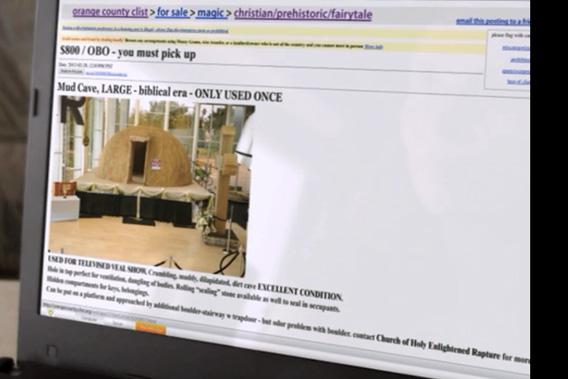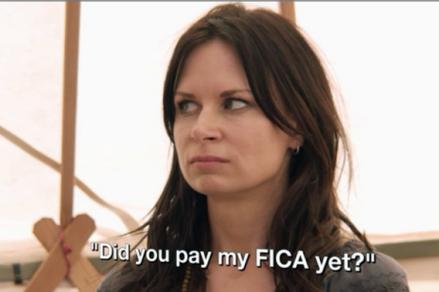In Slate’s Arrested Development TV Club, two fans will IM about each episode of Season 4 once they finish watching it. Today, culture critic June Thomas and Slate’s chief software architect Doug Harris recap Episode 2, “Borderline Personalities.”
June Thomas: Before we get into Episode 2, let’s just disclose where we are in our Season 4 watch. I’ve seen the first 10 episodes.
Doug Harris: Impressive—I’ve only watched the first two.
Thomas: I’m not sure being a couch potato is anything to be proud of, but I did find it very easy to keep pressing Next.
I’m one of those people who admired but wasn’t in love with the “original” Arrested Development—and in a weird way, I suspect that makes me more favorably disposed to this new batch. On Twitter and in the couple of reviews that I’ve read, I get the impression that hard-core fans are disappointed. Perhaps because my expectations are lower, I’m generally content with these new episodes. I have a few complaints, which we can get to later, but since you’re much fonder of the show than I am, tell me: What’s your general feeling, based on the first two episodes?
Harris: I’m very excited that they’re all back and really seem to have settled back into their characters. They all appear to have aged quite well over the past seven or so years. Even Michael Cera can still pull off whatever age he’s supposed to be. Liza Minnelli looks great; I expected to see the toll of the years on her more than the others. I’m sure she’s had some help—but she still looks pretty good.
Thomas: I so agree about Liza! I must admit that I was a bit obsessed with the actors’ appearances. The producers painted themselves into a corner by having the new episodes pick up at the very moment when Season 3 ended. I know I shouldn’t obsess about this behind-the-scenes stuff, but given the passage of time, it’s inevitable that success, or otherwise, should affect the actors’ auras as much as time changed their faces.
The passage of time also complicates the use of technology. When George Sr. snapped that picture of the blueprints in Stan Sitwell’s office, I was fixated on his ancient feature phone, but that’s what he has to be using if we’re still back in 2006.
Harris: Funny you should mention the feature phone and the timing, because it’s not clear to me just how much time has passed. Michael has an iPhone in Episode 1 with a calendar that’s stuck in 2003. They never come out and say that it’s an iPhone, of course, but geeks like me recognize it and know that the first iPhone was introduced in early 2007. And, to get even geekier, it looks like an iPhone 4 (or later), which would make it 2010.
Thomas: The chronology is definitely circular—they jump backward and forward all the time—so while a bit of the action of Episode 2 happens right after the Queen Mary runs aground, and George Sr. shows Lucille the photo he snapped in Stan Sitwell’s office pretty soon afterward, because she’s in custody, other scenes occur much later.
Harris: Right—the ambiguity of the timeline is one of the intriguing things for me so far. The first two episodes have presented a bunch of pieces to a puzzle about what’s happened since the end of Season 3. And we’ve seen at least one scene from two different points of view between Episodes 1 and 2—Michael bidding his parents a final goodbye from the hallway, and then the same from his parents’ POV in Episode 2.
Thomas: I think a puzzle is a great way to put it, and I enjoyed that a lot. I won’t spoil anything for you, but as I’m sure you’ve already gathered, the “later” episodes often explain things that happen in “earlier” episodes.
Harris: Yay! Another thing I liked about the original series that I’m pleased to see returning are the in-jokes and meta references.
Thomas: Indeed. Once again, no spoilers, but, when George Sr. had Heartfire searching for a used sweat lodge, I was very impressed by the mocked-up Craigslist page for “orange county clist> for sale> magic> christian/prehistoric/fairytale” items. Since everyone watching can freeze the frame and really examine the page, I’m glad they took the time to fill in those details. But even better, in a later episode, we see how the mud cave came to be listed in the first place.

Screenshot courtesy of Netflix
Harris: We’ve seen Stan and Sally Sitwell and Lucille 2. I’m really impressed with how many secondary characters they got to come back.
Thomas: Yes! Actors obviously love this show. We even had a Dan Harmon cameo as the yurt clerk at Father B’s retreat center. The creator of Community—a show that was low-rated but beloved by its rabid fans—who was kicked off his own show after three seasons definitely vibrates on the Arrested Development frequency.
But let’s get to our criticisms. Mine is that the episodes feel bloated—without ads, the TV versions ran 20-22 minutes. Episode 2 was the shortest of the new batch at 28 minutes, but some run as long as 35—that’s 50 percent more than the originals. I’m all for throwing off unnecessary and irrelevant broadcast restrictions, but I don’t think the added length added anything. The opposite, in fact: In pretty much all of the new Netflix episodes, there was stuff that would’ve ended up on the cutting-room floor in the Fox days—and it probably should’ve.
Harris: I certainly felt the extra length in Episode 1, which at times was even a bit too painful in stretching out Michael’s cluelessness about the dorm-room situation. You’re right, if they’re not going to use the time to build the story, they could leave more behind.
Thomas: OK, so let’s end on a positive note. What did you like best about Episode 2?
Harris: I really liked George’s complete misread of Stan Sitwell’s plans and Lucille’s different misread. I also loved the scene of Lucille smoking in the apartment with Buster’s help. What about you?
Thomas: I was glad to see George Sr. a-scamming. In the original series, his crimes were mostly in the past—we saw him trying to avoid being punished for them—so I was happy to see his sweat-and-squeeze in action. And I loved the momentary glimpse of Lucille Austero’s adopted Latino boy—it was one of the freckled bowl-cut boys from Gob’s Season 1 girlfriend Marta’s Spanish-language soap opera.
Harris: I’ve been a bit surprised by the lack of discussion of the new episodes in my social network feeds. Maybe it’s because of the fabulous holiday weekend weather on the East Coast. I’ll be watching those same feeds as the workweek begins and people have high-speed Internet and are chained to their desks.
Thomas: I follow a lot of TV critics and TV fanatics, and they’re definitely talking AD—though it’s raising hackles because of spoilers. And, indeed, for that reason I’ve been very circumspect in my tweeting. But you’re a software engineer, and given how popular the show is in the tech community, I’d expect your circle to be watching.
Harris: Oh yes, I know that many of my friends and the geeks that I follow are big fans of AD—hence my surprise. I appreciate the lack of spoilers. I don’t think that will last, though.
—
